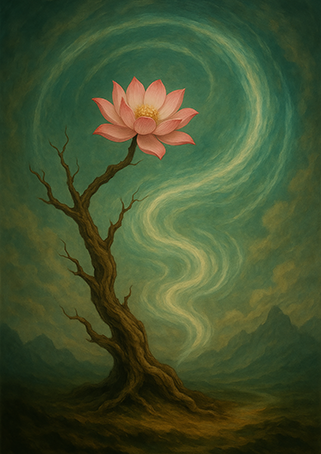Xieyi・The Rootless Tree:100 Verses-Verse 90#301

The poems of “The Rootless Tree” express a fundamental force rooted in harmony with heaven and earth, the cyclical flow of yin and yang, and the infinite potential of existence。
This painting is an expressive “Xieyi” in the tradition of “futu” (spiritual diagrams), passed down for generations in Wudang Mountain, China. It is drawn through a technique where energy flow (xingqi) channels the internal intention into visual form。 In the Taoist world, there exist spiritual and symbolic images called “futu”。
In the Taoist world, there exist spiritual and symbolic images called “futu”。
These are a type of talisman—not merely religious items, but expressive spiritual paintings that act directly on the mind of the viewer。
Since ancient times, many people have placed these Taoist-style “Xieyi” and futu in their homes, studies, or bedrooms, wishing for longevity, health, auspiciousness, and family harmony. Viewing such paintings was not just aesthetic appreciation, but an act of inviting the presence of the Dao into one’s life and tuning the body and mind。
Thus, “Xieyi” is more than artistic expression—it is a medium that bridges the spirit, life, and harmony with the universe。
This kind of artwork is not meant to be seen only with the eyes, but felt with the heart。
It communicates with the Dao, resonates with the qi of nature, and quietly stirs the viewer’s inner self。
Futu and “Xieyi” continue to live on from ancient times to this day as “sacred images that speak to the soul.”
Below, we present the original text of the philosophical poem “The Rootless Tree,” along with a modern Japanese translation and interpretation。
※ The author of “The Rootless Tree,” Zhang Sanfeng (1247–?), is also renowned as the founder of Tai Chi, and it is said that he applied the essence of this work to Tai Chi. As an additional note, we include an interpretation connecting this to the Tai Chi tradition of Wudang Mountain.
The Rootless Tree・Verse 90

▶Original Text
無根樹,花正秀,氣行無阻道自透。陰陽流轉隨勢化,太極真功貴在久。
▶Modern Translation
A graceful blossom crowns the root-less tree;
Qi flows unhindered—principle shines of itself.
Yin-yang roll and transform with the current;
True skill in Tai Chi gains value only through time.
▶Interpretation
1.[無根樹,花正秀] Elegant bloom—innate refinement.
2.[氣行無阻道自透] Free-running qi—Dao becomes transparent.
3.[陰陽流轉隨勢化] Poles flow, reshaped by momentum.
4.[太極真功貴在久] Real mastery lies in long devotion.
▶Interpretation related to Tai Chi
• Beauty arises from inner harmony, not external flair.
• Unblocked qi lets the “logic” of movement appear.
• Ride the force; adapt form to the living stream.
• Only years of steady practice reveal Tai Chi’s deepest gifts.
Copyright © MASAKI WAKABAYASHI. All rights reserved.




